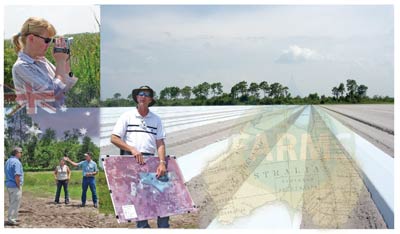
One of the District’s agricultural cooperative funding programs may have a positive impact on the health of Australia’s Great Barrier Reef.
A group of Australian sugar cane growers interested in improving water quality recently traveled to Sarasota to meet with staff to discuss the District’s Facilitating Agricultural Resource Management Systems (FARMS) Program. A sugar cane industry representative discovered the program while surfing the Internet.
“I have to admit I was quite surprised to receive email from Australia regarding our FARMS program, but I soon realized that our resource issues were not all that different,” said David Brown, a senior professional geologist with the District.
“The sugar industry and their representatives were acting in a proactive manner, much like the District, and they wanted to understand how we structured our program.”
The District and the Florida Department of Agriculture and Consumer Services (FDACS) developed the FARMS Program to help growers implement best management practices (BMPs) that address water quantity and water quality issues. The program serves as an incentive for growers within water use caution areas to install and maintain irrigation BMPs that promote surface water and groundwater resource sustainability.
FARMS also plays a pivotal role in the District’s Southern Water Use Caution Area (SWUCA) Recovery Strategy, the District’s Regional Water Supply Plan (RWSP) and the Shell Creek and Prairie Creek Watersheds Management Plan.
Growers are encouraged to develop a conceptual plan on how they would like to address a specific water-related issue. For instance, the grower may want to install soil moisture sensors in the fields to increase irrigation efficiency, or a system that will help recycle tailwater and prevent runoff. The conceptual plans are reviewed by staff and if found acceptable, recommended for funding. After the project is approved by the Basin and Governing boards, a contract between the District and the grower is signed. The contract identifies each party’s obligations, such as the scope of work, construction time table, performance monitoring and the amount the grower will be reimbursed once the project is complete and operational. To date, most projects are in the range of $200,000, with the contracts typically lasting five years.
Agricultural representatives say the flexibility of the program is key.
“It is very important to have a variety of projects, suitable to the farmer,” said Barbara Carlton, executive director of the Peace River Valley Citrus Growers Association. “Whether it is low tech or high tech, they can tailor a project to their needs.”
Several other members of Florida’s agricultural community also attended the meeting, including Cara Martin, Florida Farm Bureau; Alan Peirce, Florida Fruit and Vegetable Association; and Nate Jameson and Nicholas Streeter from the Florida Department of Agriculture and Consumer Services Office of Agricultural Water Policy.
The trip was organized by Dr. Lisa McDonald of CSR, Australia’s largest sugar company. She and three other Australian sugar cane industry representatives came to Florida to learn more about how the FARMS Program addresses water issues.
“We were interested in the FARMS Program because of the partnership between government and business,” said McDonald.
Seventy-five percent of Australia is dry, forcing growers to concentrate where water is available. Ninety-four percent of the country’s sugar cane industry is located in the state of Queensland on coastal plains and river valleys in the Burdekin River watershed, or “catchment” as described by the cane growers, because that’s where growing conditions are most favorable.
Two of the main issues the Queensland growers are dealing with are water quality and water quantity — how to prevent nutrient-filled runoff from leaving their land and how they can better utilize the rain they receive.
“It’s a big watershed and the sugar cane industry only takes up about one-half percent of the area, but it’s located at the mouth of the river,” said Kevin Mann, sugar cane grower. “Approximately 2,000 acres drain directly into the river.”
Runoff that flows into the river and eventually into the ocean has been cited as impacting the health of the Great Barrier Reef.
According to the Australian visitors, in the past, the Australian government did not see the need for a land and water management plan. In an effort to encourage growth, the government issued allocations (similar to water use permits) for a designated amount of water. Now government officials have realized they issued too many allocations and experts believe that agricultural runoff from sugar cane operations is adversely impacting downstream ecosystems.
While the Australian government is beginning to address these issues, the representatives from the sugar cane industry are also exploring solutions they can take back to their industry and local government.
The group spent two days with District staff learning about the FARMS Program and touring its projects.
The first tour was of Pacific Tomato Growers (PTG) farm near Myakka City. The 3,700-acre operation is located at the edge of Flatford Swamp. The area has experienced extensive tree die-off due to too much water entering the swamp from surrounding agricultural operations. PTG’s project is designed to remove excess water from the swamp and use it for irrigation.
Pumps at the edge of the swamp intake surface water and pipe it to an on-site reservoir. Recycled tailwater from the fields is also piped to the same reservoir. The water is then redistributed back to the fields for irrigation through another pipeline. The goal is to have the entire farm using surface water from Flatford Swamp.
The group toured four other FARMS Program projects in Charlotte and DeSoto counties before heading to south Florida to visit sugar cane growers who work with the Florida Farm Bureau on water quality projects. The group also planned to go to Gainesville and learn about the Suwannee River Partnership.
FARMS staff hope to continue to communicate with the sugar cane growers in order to share ideas and solutions to water resources issues experienced all over the world.
